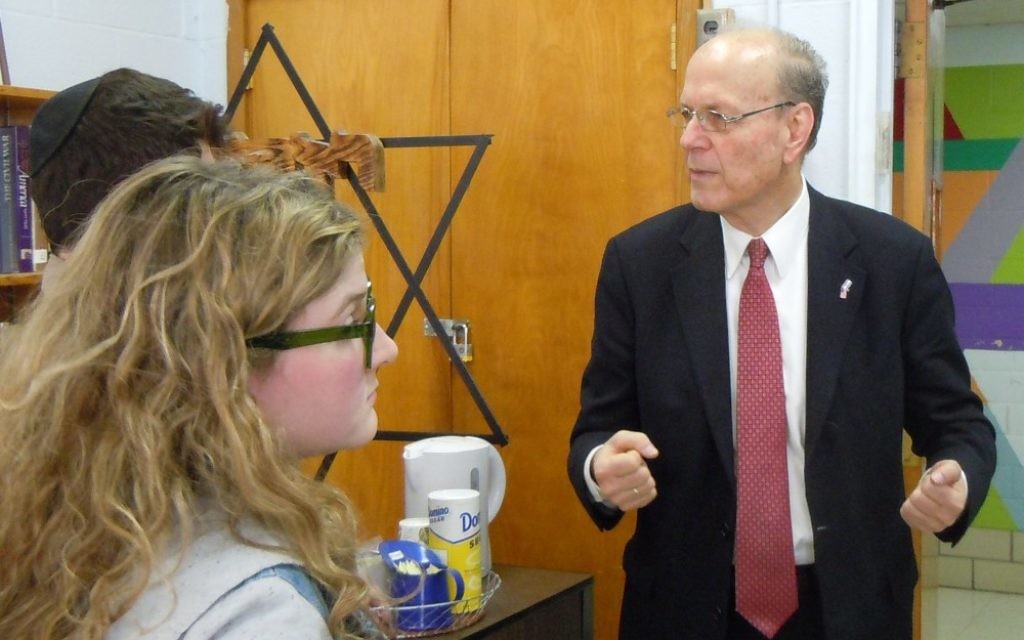Ettinger: ‘Foreign Aid’ Is U.S. Investment in Israel
The U.S.-Israel relationship shouldn’t be seen as foreign relations but as a partnership, Yoram Ettinger told an audience of Atlanta Jewish Academy students, faculty and staff Thursday, Feb. 4.
The former Israeli diplomat and active observer on U.S.-Israel relations argued that it is a mistake from the American and Israeli perspectives to talk about the $3.1 billion Israel receives each year from the United States as foreign aid.
“Americans don’t like those two words, foreign and aid,” he said, and the term is demeaning to Israel. “It paints us as a supplicant when in fact we are a producer.”
Get The AJT Newsletter by email and never miss our top stories Free Sign Up
He said the $3.1 billion is “an American investment in Israel, and the return on that investment is the highest return of any U.S. investment overseas.”
Ettinger cited several examples of how U.S. military aid to Israel benefits the United States, beyond the fact that Israel spends much of that money to buy American-made products, such as the next-generation F-35 Lightning II, part of which Lockheed Martin builds in Marietta:
- U.S. Special Operations units stop in Israel for three weeks of training on suicide bombers, car bombs and improvised explosive devices whenever they deploy to Iraq or Afghanistan. Ettinger said a soldier he talked to in Birmingham credited that training with his unit’s suffering no fatalities.
- The United States learns effective military tactics from studying Israeli operations. The smashing success against Iraq’s Soviet-made tanks in Operation Desert Storm in 1991 reflected the lessons learned from Israel’s fighting against the same types of tanks in the Sinai.
- Gen. George Keegan, who retired as the Air Force’s intelligence chief in 1977, used to say that whatever intelligence his military branch received from the CIA, it got five times as much from Israel.
- A Northrop Grumman robotics factory in Chattanooga sells anti-explosives robots to Israel. Having Israel as a customer has boosted exports to other countries, which assume Israel will buy only the best, and the robots get even better because of weekly teleconferences in which Israeli experts offer feedback on operations, repairs and maintenance. The robot has effectively gained 10 to 20 years of research and development in far less time and at no cost, driving sales and employment.
- Lockheed’s F-16 plant in Fort Worth, Texas, continually receives lessons learned from Israeli pilots, who push the fighter plane to its limits because every flight they make is within radar and missile range of enemies. A plant manager told Ettinger that roughly 700 modifications to the current F-16 resulted from Israeli feedback, including 70 percent of the changes to the fire control system and 50 percent of the improvements to the cockpit. Those changes have been worth many billions of dollars to Lockheed, and Ettinger said the story is the same for hundreds of U.S. military systems.
“Israel constitutes the largest, most cost-effective and battle-tested laboratory of the American defense industries,” Ettinger said.
He said that despite the personal rift between President Barack Obama and Prime Minister Benjamin Netanyahu, the U.S.-Israel relationship has never been stronger or more mutually beneficial, and it continues to grow in R&D areas such as high tech, agriculture, water and space.
The one concern Ettinger has is the stigma associated with “foreign aid.” His proposed solution is to phase out the $3.1 billion over a decade, each year diverting $310 million from the aid budget into a joint U.S.-Israeli venture fund focused on a particular area of shared interest, such as satellites, nanotechnology and cybersecurity.
After 10 years, the aid budget would be gone, but the two countries would have 10 well-funded foundations from which to invest in R&D for decades to come.






comments